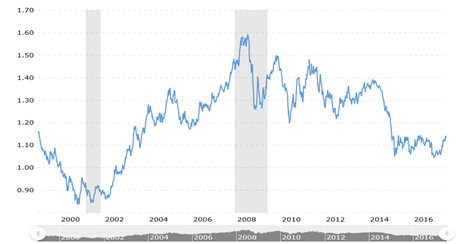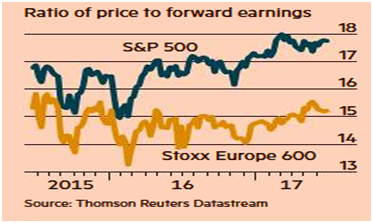According to most valuation metrics, European stocks trade at a discount relative to those in the US. Consequently, fund managers are on a shopping spree for EU-based equities. As a result the Euro has been strengthening against the dollar. Certainly, the strengthening of the Euro is also significantly related to other factors such as overall strengthening of the EU-wide economy (at least on paper and for the time being), as well as misfiring related to US international policy.
Of course – and as the graph below shows – the Euro has lost almost 30% from its high back in 2008, or almost 20% from its value in late 2013/early 2014.

Is it possible then that we could see the Euro rising back to levels seen in early 2014? My short answer to this is that this is almost impossible, unless US monetary and fiscal policies completely misfire. The near certainty is based on the fact that US rates will continue being significantly higher than EU rates, the US economy is not expected to go into recession in the next year, and the economic fundamentals in the US are stronger than those in the EU.
“Where do the metrics fit then?” someone may ask. I would say that when we look at the Ratio of Price to Forward Earnings, then we would discover that the metric stands at around 17.8 in the US, while the similar measure is around 15.2 in Europe, as is shown below.

The stronger EU-wide economy is attracting capital then, but we do not expect that US tactics of buybacks will work out as well in Europe, relative to what they achieved in the US over the last five years. The fact is that in the US, buybacks financed through higher corporate debt lifted up the US equities market, but we do not expect the buybacks to have the same effect in the EU. We would rather expect that EU-based companies will choose to raise their dividends; therefore, one might consider a limited portfolio rebalancing strategy in which a portion of the portfolio is targeting EU-based companies or funds with a history of good and rising dividends.
We would say that as currency swings may continue in the foreseeable future, our expectation is that central banks (mainly in Asia) will intervene for the purpose of reducing the scale of unwelcome currency swings, rather than holding back the tide. We should especially watch the Chinese central bank (PBoC) at the end of the three month options expiration dates, when they temporarily may intervene to scale down the Renminbi’s devaluation while allowing its downward trend to continue, thus partially offsetting the economic slowdown through higher exports.
In closing, it seems that portfolio rebalancing should be more of a Kantian nature (where we examine the basis of our knowledge and understanding allowing such examination to revise tactics and if needed strategies based on developments), rather than of Johann Fichte’s approach where the thesis-antithesis-synthesis approach (resembling traditional asset allocation models) does not allow macro-related risk to be reflected in asset allocation. My fear is that nowadays Fichte is winning and that endangers us to the point that we may end up adopting his ideas found in his book “The Closed Commercial State”.
Valuation Metrics, Currencies, and Portfolio Rebalancing: Kantian of Fichte?
Author : John E. Charalambakis
Date : July 6, 2017
According to most valuation metrics, European stocks trade at a discount relative to those in the US. Consequently, fund managers are on a shopping spree for EU-based equities. As a result the Euro has been strengthening against the dollar. Certainly, the strengthening of the Euro is also significantly related to other factors such as overall strengthening of the EU-wide economy (at least on paper and for the time being), as well as misfiring related to US international policy.
Of course – and as the graph below shows – the Euro has lost almost 30% from its high back in 2008, or almost 20% from its value in late 2013/early 2014.
Is it possible then that we could see the Euro rising back to levels seen in early 2014? My short answer to this is that this is almost impossible, unless US monetary and fiscal policies completely misfire. The near certainty is based on the fact that US rates will continue being significantly higher than EU rates, the US economy is not expected to go into recession in the next year, and the economic fundamentals in the US are stronger than those in the EU.
“Where do the metrics fit then?” someone may ask. I would say that when we look at the Ratio of Price to Forward Earnings, then we would discover that the metric stands at around 17.8 in the US, while the similar measure is around 15.2 in Europe, as is shown below.
The stronger EU-wide economy is attracting capital then, but we do not expect that US tactics of buybacks will work out as well in Europe, relative to what they achieved in the US over the last five years. The fact is that in the US, buybacks financed through higher corporate debt lifted up the US equities market, but we do not expect the buybacks to have the same effect in the EU. We would rather expect that EU-based companies will choose to raise their dividends; therefore, one might consider a limited portfolio rebalancing strategy in which a portion of the portfolio is targeting EU-based companies or funds with a history of good and rising dividends.
We would say that as currency swings may continue in the foreseeable future, our expectation is that central banks (mainly in Asia) will intervene for the purpose of reducing the scale of unwelcome currency swings, rather than holding back the tide. We should especially watch the Chinese central bank (PBoC) at the end of the three month options expiration dates, when they temporarily may intervene to scale down the Renminbi’s devaluation while allowing its downward trend to continue, thus partially offsetting the economic slowdown through higher exports.
In closing, it seems that portfolio rebalancing should be more of a Kantian nature (where we examine the basis of our knowledge and understanding allowing such examination to revise tactics and if needed strategies based on developments), rather than of Johann Fichte’s approach where the thesis-antithesis-synthesis approach (resembling traditional asset allocation models) does not allow macro-related risk to be reflected in asset allocation. My fear is that nowadays Fichte is winning and that endangers us to the point that we may end up adopting his ideas found in his book “The Closed Commercial State”.